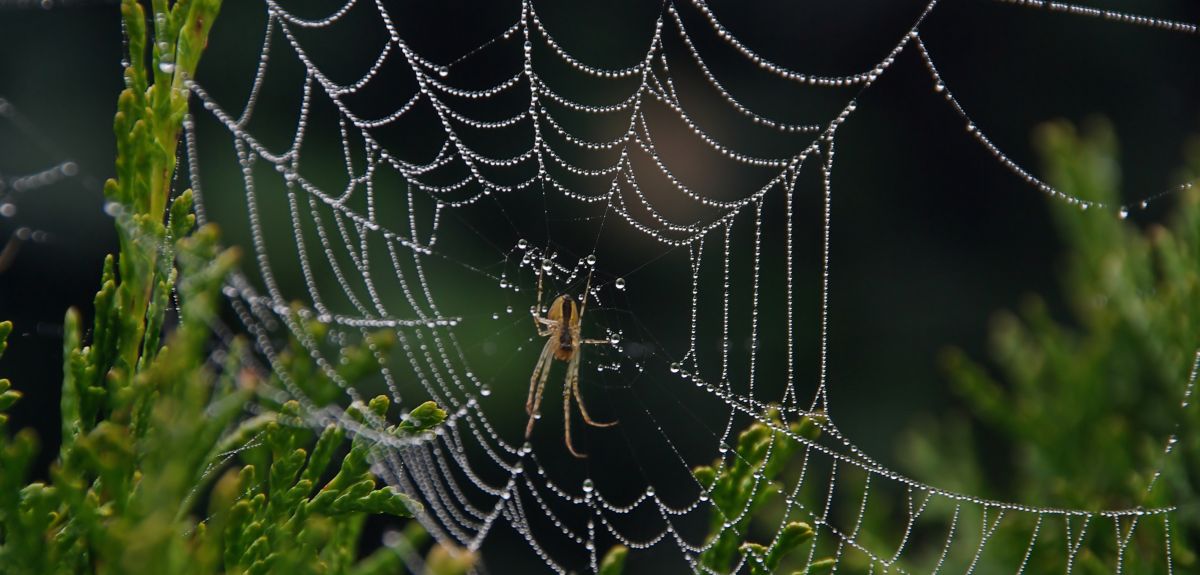
Image credit: Shutterstock
Good vibrations: spider signal threads reveal remote sensing design secrets
When you look at a spider web in the garden, one thing is often noticeably absent: the spider. This may be because it is lurking away from the web in a 'retreat', where it can monitor web vibrations through a proxy known as a signal thread.
A new Oxford study published in Journal of the Royal Society Interface looks in more detail at the composition and structure of these signal threads, which spiders can use to tell whether they've caught new prey.
Dr Beth Mortimer from the Oxford Silk Group, based in the Department of Zoology, spoke to Science Blog about the research.
How much do we already know about signal threads?
'The sector web spider is a very common spider in the UK – even at this time of year you can see their two-dimensional orb webs that have a top corner with a free sector (there is no 'capture spiral' in this section). What you won't notice necessarily is the spider – they will sit away from the web in a retreat and use a signal thread (a single line of silk fibres) to remotely monitor web vibration by proxy.
'We know that the signal threads are made from silk and are likely to be made of the same material as the other radial threads in the web – a silk called spider dragline silk, known for its strength and toughness. These signal threads are the last part of the web to be built. The signal threads are multipurpose: they function not only to transmit vibrations from the web to the spider in the retreat, but also as a tightrope for the spider as it moves from the retreat to the web and back again. The spiders that employ signal threads seem to make the most of the added protection from a retreat, while still being able to detect the important web vibration signals from afar.'
What does this new study tell us?
'This paper reveals the structure of the signal threads and gives insights into how they are able to achieve their multi-purpose functions. Firstly, the signal thread structure is surprisingly variable: while some had only four fibres in their signal thread rope, others had up to 16 fibres. The number of fibres and the load-bearing capacity of the signal threads varied with the movement of the spiders – each time they ran from the retreat to the hub, more silk fibres were added to the signal thread, which was then able to sustain more weight.
'The implications of the variable structure of the signal threads are carefully controlled by the spider. As more fibres are added to the signal thread, the spider carefully tensions each one to simultaneously increase the overall tension of the signal thread. This is important, as the vibrational properties of the signal thread remain constant across many different signal thread sizes. We also show that these fibres closely interact with each other to form a signal thread that behaves as one unit – which gives a comparatively simple vibration signal to the spider.
'Overall, the signal thread structure and properties give freedom to the spider to move along the signal thread to and from the web as opportunities for prey capture arise.'
What are the potential applications of this knowledge?
'Learning from nature, signal threads could provide inspiration for the development of new remote sensing technologies. Firstly, the signal thread structure enables consistent signalling across a range of cable sizes – so it could be employed in contexts where passive monitoring is required. Secondly, the system would be well suited to active sensing of vibrations – the combination of the signal thread's structure and piezoelectric coatings could provide new systems for small-scale energy harvesting, where vibrations could be turned into electricity. These types of systems could be useful in micro-electronic-mechanical systems, but also in large-scale civil applications. The variability of the natural system therefore gives insights into how this simple system can be tuned for a range of different size scales.'